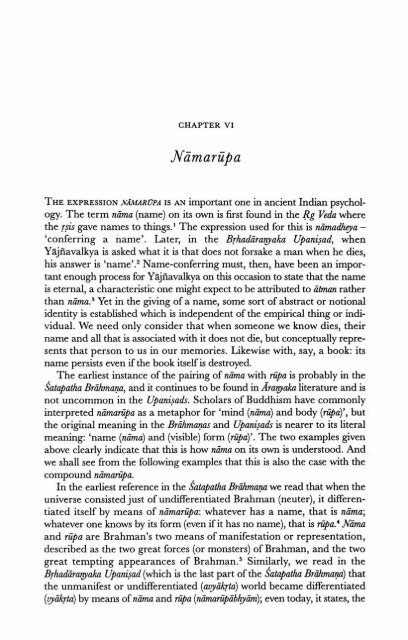Identity and Experience_Hamilton_1996
Identity and Experience_Hamilton_1996
Identity and Experience_Hamilton_1996
You also want an ePaper? Increase the reach of your titles
YUMPU automatically turns print PDFs into web optimized ePapers that Google loves.
CHAPTER VI<br />
Niirnariipa<br />
THE EXPRESSION N&UXZDPA IS AN important one in ancient Indian psychology.<br />
The term nima (name) on its own is first found in the Rg fida where<br />
the pis gave names to things.' The expression used for this is nimadhya -<br />
'conferring a name'. Later, in the Byhadiranyaka Upani?ad, when<br />
Yajfiavalkya is asked what it is that does not forsake a man when he dies,<br />
his answer is 'name'.* Name-conferring must, then, have been an important<br />
enough process for Yajfiavalkya on this occasion to state that the name<br />
is eternal, a characteristic one might expect to be attributed to itman rather<br />
than nii~na.~ Yet in the giving of a name, some sort of abstract or notional<br />
identity is established which is independent of the empirical thing or individual.<br />
We need only consider that when someone we know dies, their<br />
name <strong>and</strong> all that is associated with it does not die, but conceptually represents<br />
that person to us in our memories. Likewise with, say, a book: its<br />
name persists even if the book itself is destroyed.<br />
The earliest instance of the pairing of nirna with riipa is probably in the<br />
Satapatha Briihmap, <strong>and</strong> it continues to be found in Aranyaka literature <strong>and</strong> is<br />
not uncommon in the Upani~ads. Scholars of Buddhism have commonly<br />
interpreted nZmanipa as a metaphor for 'mind (naina) <strong>and</strong> body (riipa)', but<br />
the original meaning in the Briihmaps <strong>and</strong> UpanSads is nearer to its literal<br />
meaning: 'name (nima) <strong>and</strong> (visible) form (riipa)'. The two examples given<br />
above clearly indicate that this is how nima on its own is understood. And<br />
we shall see from the following examples that this is also the case with the<br />
compound niimariipa.<br />
In the earliest reference in the Satapatha Brtilmap we read that when the<br />
universe consisted just of undifferentiated Brahman (neuter), it differentiated<br />
itself by means of nZmarfipa: whatever has a name, that is nima;<br />
whatever one knows by its form (even if it has no name), that is riipa.* NZma<br />
<strong>and</strong> riipa are Brahman's two means of manifestation or representation,<br />
described as the two great forces (or monsters) of Brahman, <strong>and</strong> the two<br />
great tempting appearances of Brahman.= Similarly, we read in the<br />
&rhad6ranyaaka Upani!ad (which is the last part of the Satqpatha Bramapa) that<br />
the unmanifest or undifferentiated (auyiibta) world became differentiated<br />
(zy&tu) by means of nrima <strong>and</strong> riipa (n&wmipZbhjva'm); even today, it states, the


